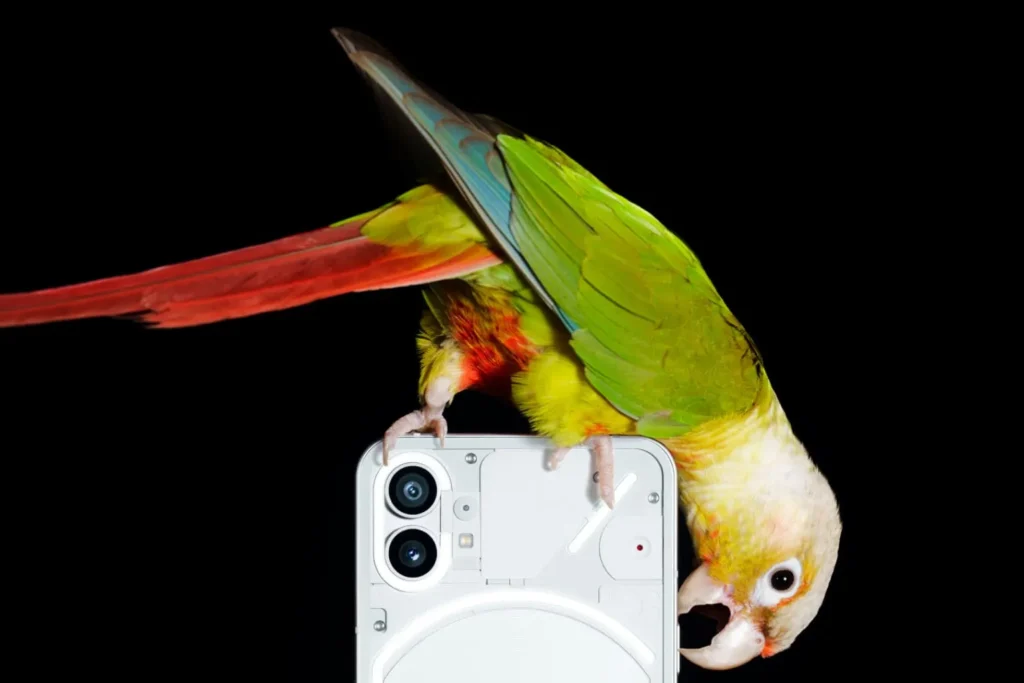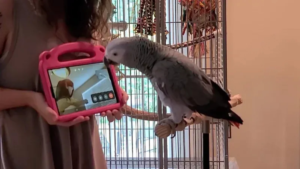Parrots fight loneliness with video chats! Discover how technology is improving the lives of these social birds.
Introduction: Lonely parrots learn to video chat
Recent studies have demonstrated that lonely pet parrots can significantly benefit from video chatting with other parrots. Researchers from Northeastern University, the University of Glasgow, and MIT conducted a study where they taught domesticated parrots to use video calling technology to interact with each other. This initiative was driven by the understanding that parrots are highly social creatures that often suffer from isolation when kept as pets.
Key Findings from the Study
- Social Interaction: Parrots engaged in various social behaviors during video calls, such as mirroring movements, dancing, singing, and even showing toys to each other. These interactions mimic those that occur in natural flock environments.
- Learning and Development: The parrots not only maintained social interactions but also learned new skills from each other, such as foraging techniques and new sounds. This aspect of the study highlights the cognitive benefits of social interaction among parrots.
- Emotional Well-being: Owners and researchers observed that the parrots appeared more lively and less isolated as a result of these video interactions. Some parrots continued to seek out these interactions, indicating a lasting positive impact on their well-being.
- Safety and Health Considerations: Given that a high percentage of pet parrots can carry transmissible diseases, video calls provide a safe way to interact without the risk of disease transmission. This is particularly important as physical interactions could potentially spread diseases like avian ganglioneuritis.

Implementation and Precautions
The study involved a careful setup where parrots were trained to initiate calls by ringing a bell and then selecting a fellow parrot’s image on a tablet. This method ensured that the parrots had the agency to choose when and whom to call. The calls were monitored by the owners to prevent any signs of distress or aggression, and calls were limited to short durations to maintain the birds’ attention.
Broader Implications
This research not only sheds light on the social needs of parrots but also opens up discussions about the welfare of other socially complex animals. It suggests that technology can play a role in enhancing the lives of pets, especially those that require high levels of social interaction. The study’s findings could potentially be applied to other animals that are kept in isolation, thereby improving their quality of life through technological interventions.
In conclusion, the ability of parrots to use video calling technology effectively addresses their social needs, reduces feelings of loneliness, and enhances their overall well-being. This innovative approach could serve as a model for improving the lives of other captive animals facing similar challenges.
How did the scientists teach the parrots to video call each other?
The scientists taught the parrots to video call each other through a carefully structured training process that involved several key steps. Initially, the parrots were introduced to the concept of making video calls through a combination of bell-ringing and touchscreen interactions. Here’s a summary of the training process based on the provided sources:
- Introduction to the Concept: The parrots were first introduced to the idea of video calling by being trained to associate ringing a bell with the initiation of a call. This was done to help the parrots understand that a specific action (ringing the bell) could lead to a social interaction.
- Using Touchscreen Tablets: After learning to ring the bell, the parrots were taught to touch a photo of another bird on the screen of a tablet device. This action would trigger a call to the selected bird. The training ensured that the parrots understood the connection between selecting an image and initiating a video call.
- Supervised Initial Calls: The initial calls were closely supervised by the caretakers, who were trained to assist at both ends of the call. These introductory calls were strictly limited to a maximum of five minutes, and the caretakers would terminate the call as soon as the parrot’s attention wandered. This phase was crucial for ensuring that the parrots were comfortable with the process and to prevent any negative experiences.
- Open Call Sessions: Once the parrots were comfortable with the basics of making a call, they entered a phase where they could choose to call other birds at their own will. This was done by ringing the bell and then selecting the bird they wanted to call from a home screen featuring photographs of different birds in the study. This phase allowed the parrots to exercise agency in choosing whom to call.
- Monitoring and Ethical Considerations: Throughout the training and study, strong ethical guidelines were followed to ensure the well-being of the parrots. Caretakers were thoroughly trained to monitor the birds’ behavior during calls and to end the calls if any signs of distress or discomfort were observed. This careful monitoring was essential to ensure that the video calling experience was positive for the parrots.
This innovative training process enabled the parrots to make and receive video calls, allowing them to engage in social behaviors such as preening, singing, and play, which are crucial for their emotional well-being. The study demonstrated that with proper training and supervision, pet parrots could use technology to mitigate feelings of isolation and enhance their social lives.
How long did it take to train the parrots to video call each other?
The training process for the parrots to learn how to video call each other took two weeks. During this initial training period, the parrots were taught to ring a bell and then touch a photo of another bird on a tablet screen to initiate a video call. This training was conducted with the assistance of their caretakers, who were present to help facilitate the calls and ensure the interactions were positive and controlled.
What was the purpose of teaching parrots to video call each other?
The purpose of teaching parrots to video call each other was to explore whether these highly social birds could benefit from digital social interactions to mitigate feelings of loneliness and isolation, which are common in domesticated parrots living in captivity. The research aimed to replicate some of the social behaviors that parrots engage in when living in flocks in the wild, such as communicating, preening, and playing, thereby improving their well-being and behavior in a domestic setting.
How did the parrots’ behavior change after being taught to video call each other?
After being taught to video call each other, the parrots exhibited a range of positive behavioral changes, which included increased social behaviors and the development of new skills:
- Increased Social Interaction: The parrots engaged in more social behaviors such as preening, singing, and playing during the video calls. This interaction is similar to the social activities they would engage in within a natural flock environment.
- Reduction in Feelings of Isolation: The parrots showed signs of feeling less lonely and isolated. This was a significant observation as parrots are highly social animals and isolation can lead to psychological issues.
- Learning New Skills: Some parrots learned new skills from their interactions with other parrots over the video calls. For instance, they learned new vocalizations and even physical activities like flying and foraging, which they hadn’t done before.
- Formation of Friendships: The parrots developed preferences for certain peers, often choosing to call the same birds repeatedly, which indicates the formation of friendships. This was measured by the frequency of calls initiated and received among the parrots.
- Behavioral Enrichment: Owners and researchers noted that the parrots seemed more engaged and exhibited a variety of behaviors during the calls. Some parrots were playful, showing toys to their peers, while others might sing or even fall asleep next to the screen, indicating a comfort with the interaction.
- Positive Emotional Impact: The overall mood and well-being of the parrots improved. Owners reported that their pets seemed happier and more lively as a result of these interactions.
These changes highlight the significant positive impact that technological interventions like video calling can have on the social and psychological well-being of highly social animals like parrots.
Conclusion:
The initiative to teach parrots to video call each other has demonstrated a significant breakthrough in addressing the social needs of these highly intelligent and social creatures. The training process, which took about two weeks, involved teaching the parrots to initiate video calls by ringing a bell and selecting a fellow parrot’s image on a tablet. This innovative approach aimed to mitigate the feelings of loneliness and isolation that parrots often experience in domestic settings.
The results of this study were overwhelmingly positive. Parrots engaged in a variety of social behaviors during the video calls, such as singing, dancing, and showing toys to each other, which are indicative of natural flock behaviors. These interactions not only reduced feelings of isolation but also led to the development of new skills and behaviors among the parrots. They learned new vocalizations and foraging techniques from each other, demonstrating the cognitive benefits of social interaction. Furthermore, the parrots formed friendships, choosing to call specific peers more frequently, which suggests a preference for certain individuals.
The emotional well-being of the parrots also saw a notable improvement. Owners and researchers observed that the parrots appeared more lively and less isolated, with some continuing to seek out these interactions even after the study concluded. This indicates a lasting positive impact on their well-being.
This study not only sheds light on the complex social needs of parrots but also opens up discussions about the welfare of other socially complex animals. It suggests that technology can play a crucial role in enhancing the lives of pets, especially those that require high levels of social interaction. The findings could potentially be applied to improve the quality of life for other animals kept in captivity, thereby promoting their psychological and emotional well-being.
In conclusion, the ability of parrots to use video calling technology effectively addresses their social needs, reduces feelings of loneliness, and enhances their overall well-being. This innovative approach could serve as a model for improving the lives of other captive animals facing similar challenges, highlighting the potential of technology in animal welfare and behavior studies.
